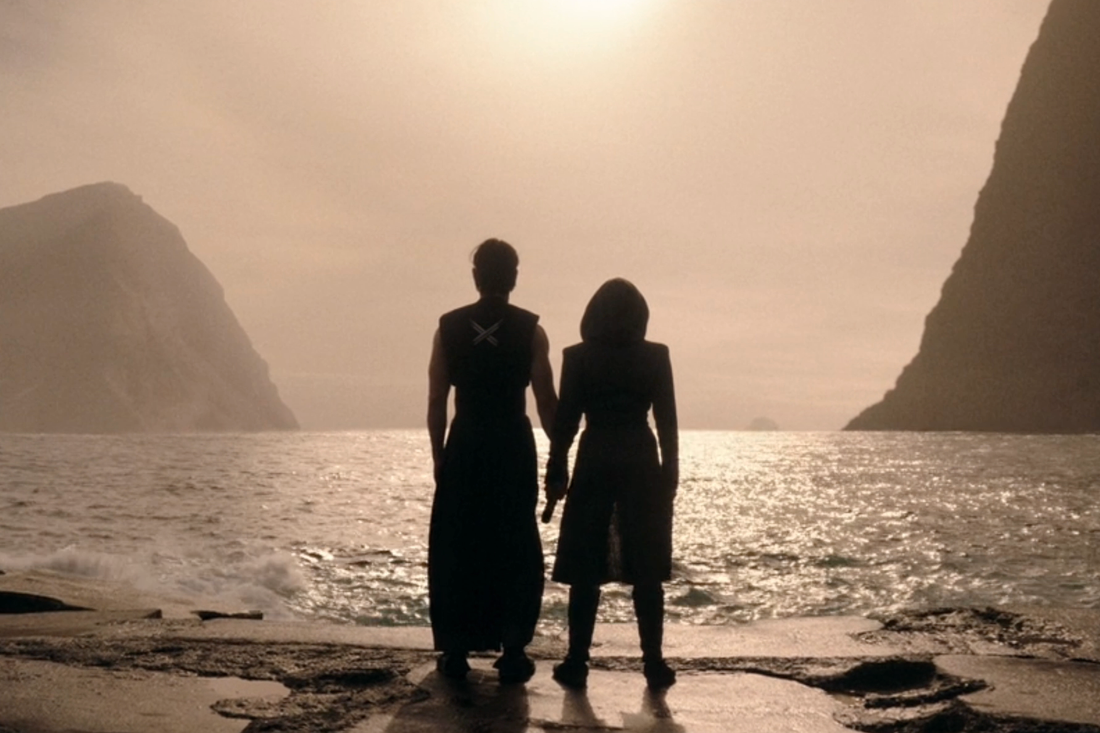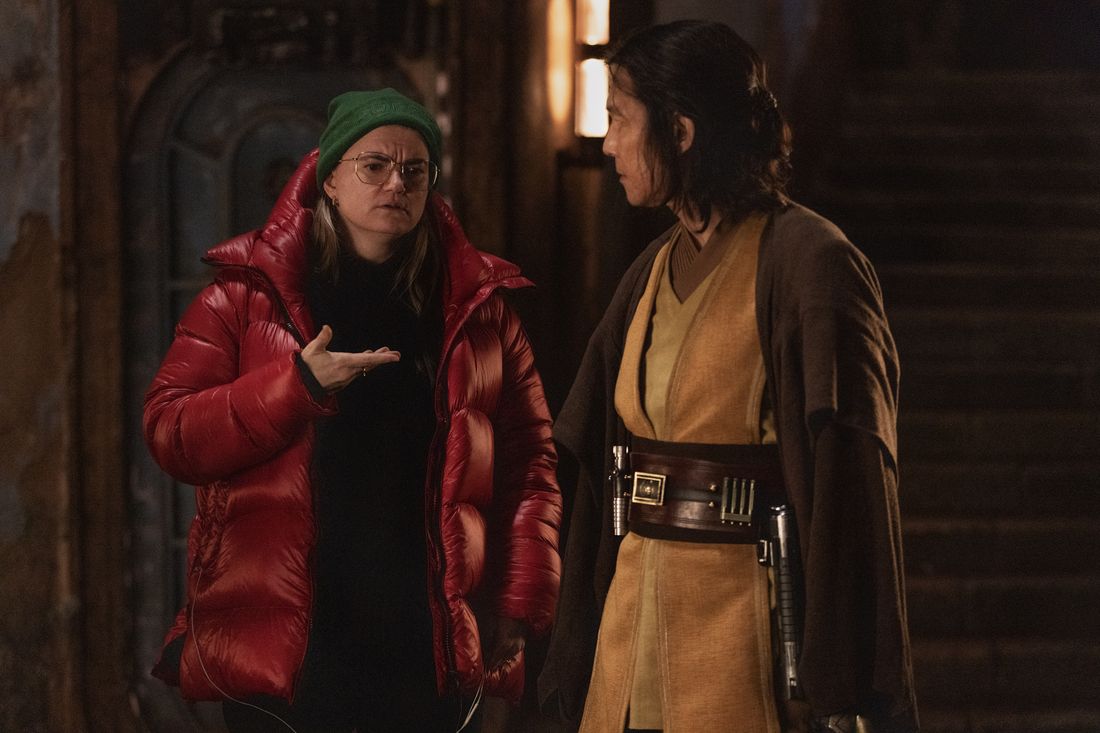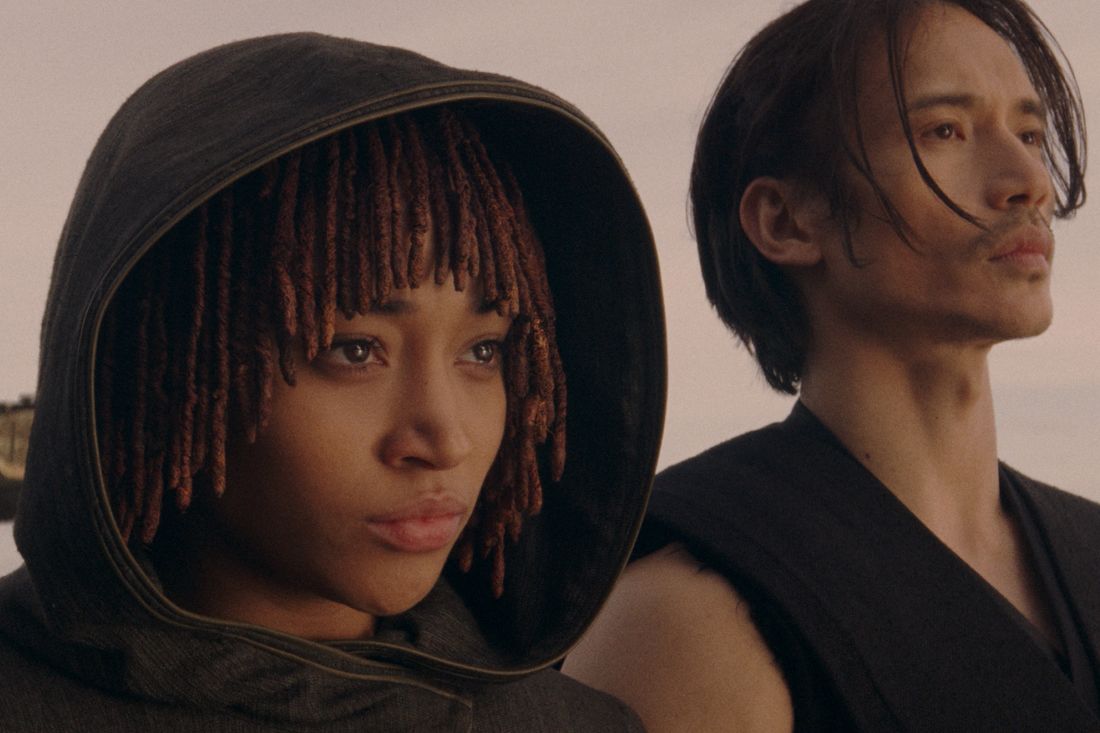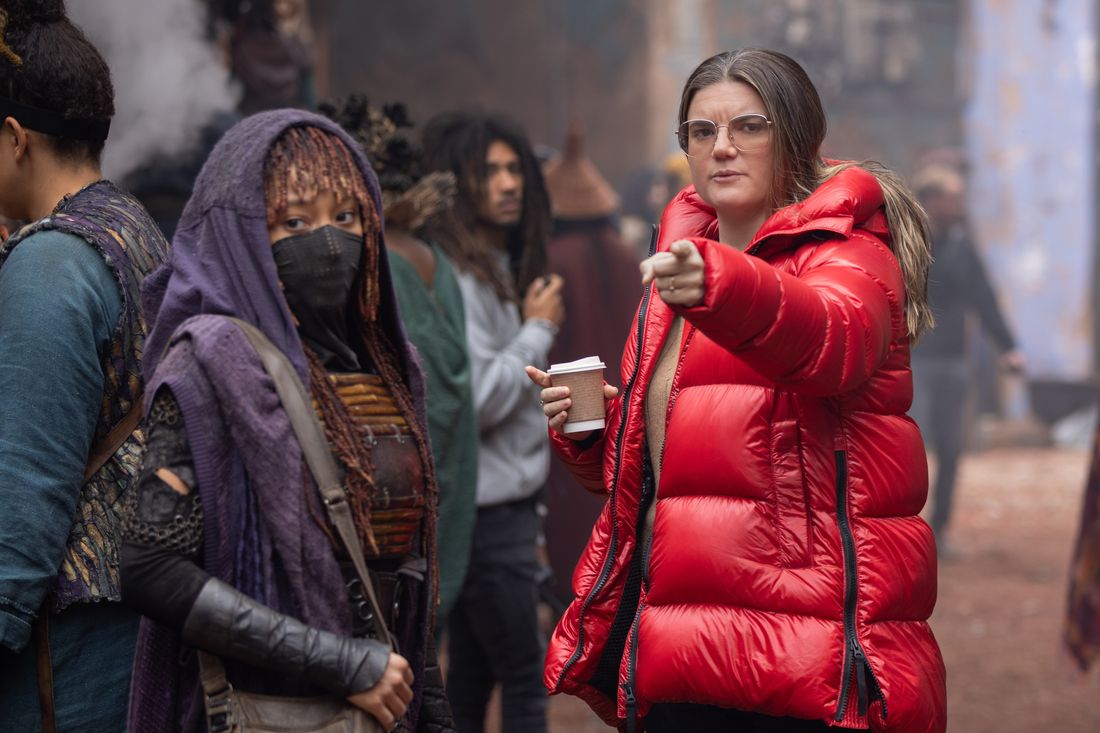
As a woman who has grown up feeling disrespected and overlooked in various aspects of my life, I can deeply relate to the experiences of young female fans of “The Acolyte.” It’s heartening to see a character like Mae, whose story feels specifically tailored for me. The way she is given agency and validation, especially when it comes to her desires and her sexuality, resonates on a deep level.
Spoilers ahead for the season-one finale of The Acolyte.
Leslye Headland, the creator of Disney+ “Star Wars” series “The Acolyte,” often pondered why female characters in mainstream media are seldom portrayed as evil. In contrast, Osha, played by Amandla Stenberg in this show, doesn’t shy away from darkness. Initially an unsuccessful Jedi trainee, she succumbs to her emotions and joins the dark side over eight episodes. Her twin sister Mae (also played by Stenberg) seeks vengeance against the Jedi, while the enigmatic Stranger, portrayed by Manny Jacinto under the alias “Qimir,” coaches Mae before focusing on Osha. In the season finale’s thrilling conclusion, Osha unleashes her suppressed anger towards her former master Sol (Lee Jung-Jae), taking revenge for her mother’s death by killing him and transforming his lightsaber from blue to red with the extracted Kyber crystals.
In this scene and throughout the series, “The Acolyte” brings a melancholic twist to familiar “Star Wars” motifs and concerns: the relationship between Luke and Anakin in “Return of the Jedi” is reimagined as a father-daughter dynamic, with reconciliation failing to occur. The Jedi order appears less honorable than before in the show, while the Sith emerge as more rational or alluring. Some “Star Wars” fans have been divided by this interpretation of the lore or the addition of political themes by Headland. (“George made it political!” Headland retorts. “Remember, ‘Star Wars’ is called that for a reason – wars are inherently political!”)
For Headland as a writer, the shift to franchising with “The Acolyte” might appear unexpected. However, the show’s themes align perfectly with her past work. Known for her early career as a playwright, she authored seven pieces focusing on the seven deadly sins. One of these, “Bachelorette,” was adapted into a film, while another titled “Cult of Love” about pride will debut on Broadway this fall. Following the success of her Netflix series “Russian Doll,” Headland seized an opportunity to write for Lucasfilm, exploring the complexities of Star Wars’ villains. Her interest in examining sin and human emotions onstage mirrors her fascination with these troubled characters in Star Wars. Furthermore, she delves into how individuals are influenced by institutions and can develop harmful patterns in response. “Everyone believes they’re the good guy,” Headland shares, “and empathizing with their struggles is what drives me. I was fortunate enough to contribute to this cherished universe while staying true to myself.”
In the final scene, it was intended for Osha to end Sol’s life as he expressed his love for her. Luke, being the noble and compassionate hero in our “Star Wars” tale, chose forgiveness over vengeance by discarding his lightsaber. This moment served to eliminate the destructive generational cycle between them, a crucial aspect of this story focusing on “Star Wars” villains.
Over the span of eight episodes, it became clear to us that Osha deeply trusted and cared for Sol, longing for the affection she had experienced as a child. Though the Jedi might not express it with that term, her yearning was rooted in what we call “love.” She felt compelled to declare, “Your words of love hold no significance to me; I have spent my entire life in its absence.”
Star Wars explores family relationships, particularly the Skywalker lineage, often focusing on father-son dynamics. A scene that has deeply impacted me since my childhood is Luke’s confrontation with Vader in the Dagobah cave. When he removes Vader’s helmet and sees his own reflection, questions arise: What if I am the antagonist? Do I feel like a villain, but I’m not? Am I being judged harshly by those closest to me? Or is this dark side, which I fear, something I need to accept within myself?
Originally, I intended to delve into the intricacies of a sibling bond. However, midway through the creative process, my father fell ill. Consequently, the narrative evolved into a heartfelt exploration of the father-daughter relationship. Sadly, he passed away in September. As the story progressed, I found myself deeply immersed in my own emotions regarding his illness and our past.
If your father is like Sol’s character, you might find it difficult to see his paternalistic ways as limiting. Osha must sever ties with her father for her own progression. In the Star Wars saga, reconciliation is common between fathers and sons, but not so much between fathers and daughters.
Sol’s the one who gives young Osha the chance to hold a lightsaber, and then when she leaves the Jedi she has it taken away. It’s compelling, then, that the Stranger is the one who offers her the chance to hold one again. Here’s a woman coming of age through this power her father gave and then denied her, entwined with her discovering her sexuality.
There is danger in Manny’s character, too. You should question his philosophy because it is just another philosophy. But he’s telling her his truth and she can ascribe to it or not. He can see in her — and she can see in him — the reflection of losing something. She’s being offered a different way. The question is, Do you reject that other way because of the implication that the dark side is wrong, without ever having tapped into it? Or do you accept it because it’s already there inside you?

As a seasoned screenwriter with a unique voice and perspective, I took Kathleen Kennedy’s words to heart. She didn’t just want me to deliver a good Star Wars story; she desired something that carried my signature as a storyteller. That meant pushing boundaries and tackling themes that resonated deeply with me. I was challenged to dig into the aspects of the Star Wars universe that scared or intrigued me, and bring those emotions to life on the screen.
As a fan of your work, I’ve noticed that you have a knack for creating emotionally scarred characters who struggle to heal and are often drawn back to their wounds. Your plays explore the allure of surrendering to our deeper emotions.
Initially, I hadn’t considered the gender of my characters; it wasn’t a conscious exploration for me. However, upon reflection, I realized that many of my protagonists are influenced by societal or institutional expectations to conform. In “Bachelorette,” it’s the pressure of the wedding industry. In “Sleeping With Other People,” it’s the belief that being attracted to someone who doesn’t reciprocate feelings is a personal flaw. In “Russian Doll,” Nadia uses her cool downtown New Yorker persona as a shield, discovering it’s a way to avoid introspection.
As someone who has felt trapped by societal expectations and rigid institutions throughout my life, I wholeheartedly relate to the allure of letting go and starting anew. The character of Tyler Durden in “Fight Club” resonated deeply with me, as he represented a seductive escape from the mundane and confining world around me.

After parting ways with Osha and the Stranger, they are shown staring out at the ocean in a scene reminiscent of the conclusion in “Fight Club.” This effect was unplanned yet deliberate. During the shot setup, I discovered the similarity and enhanced it to amplify the feeling. These two characters aim to destroy the world, but they won’t make it far enough to dismantle the aspects that threaten their existence. The irony lies in their inability to reach the part of the world that restricts them.
The story begins with a brawl in a teahouse reminiscent of fights depicted in wuxia films, which has significantly influenced “The Acolyte.” Did this aspect figure into the original proposal?
In the story of “Crouching Tiger,” Jen is frequently faced with temptation from various mentors, such as Jade Fox or Li Mu Bai. The struggle with choosing between these opposing influences forms a significant theme for Osha. Originally, we intended to portray two sisters with an immense rift between them, leaving room for exploration of potential common ground and reconciliation. Given our plans for additional seasons and my personal family experiences, this question was deliberately left open-ended. Kathleen Kennedy proposed that they be twins as she is one herself, leading us to consider casting an actor who could convincingly portray two distinct characters influenced by two male figures presenting alternative paths.
You wanted multiple seasons — was this designed to be a series finale?
A lot of things are left open-ended that I would love to continue exploring. I do feel, however, that we had to tell a complete story. In the streaming era, a lot of first seasons are essentially the first act of a story. I wanted to tell a whole story. There are a lot of little things, like about Vernestra being Manny’s character’s master, Osha making the decisions she makes, the legacy characters that show up. I definitely designed it to launch into another chapter, but I was like, Don’t assume we’re getting a second. I learned that on Terriers. Shawn Ryan and Ted Griffin were like, “We’ve gotta throw it all in there.”
In the final scene, we bring in a surprise appearance by Darth Plagueis, observing Mae and the Stranger. He is the former master of Palpatine, scarcely mentioned in the movies but beloved by fans due to his connection to Palpatine’s backstory. How came you decide to incorporate him into your narrative?
Plagueis, if you believe Palpatine, had the power to create life, which is something that comes up in Star Wars lore. Anakin is a virgin creation, too — and is himself a vergence of the force. Now you’ve introduced the idea that Aniseya created Osha and Mae through a vergence on this planet Brendok.
I was interested in the fact that this power would’ve existed on its own. A vergence on a planet is a naturally occurring concentration of the force if it’s in a location rather than a person, like Anakin. It would be like tapping into oil. The Jedi are seeing these women tap into this vergence like they’re tapping into a natural resource. It wouldn’t fit into the Jedi’s idea for that to be left unregulated.
In a universe where the Skywalker clan’s story initially centered around traditional heterosexual family dynamics, it adds an intriguing twist to bestow the power of creation onto this all-female group. The contrast between these women and their original families, set against the backdrop of a society that has historically been matriarchal but with paternalistic undertones, creates a thought-provoking exploration of gender roles and power dynamics within the context of female relationships. This new dynamic challenges the traditional paternalistic expectations of Jedi masters towards their students and adds an intriguing layer to the storyline.

You have a play, Cult of Love, coming to Broadway this fall. It’s about a Christian family gathering for the holidays. It’s inspired by your own experiences with your family. You were working on it at the same time as The Acolyte, from what I can tell. Did they influence each other?
Our director, Trip Cullman, and I were talking about how it’s called Cult of Love because all cults have a dream, and the dream is really beautiful. Even Jim Jones started out trying to desegregate Indianapolis. This family in the play has this dream that they follow to the logical conclusion, which is that they never achieve it. I was raised Christian. Christianity is the ultimate dream. It’s a beautiful concept that God becomes human in order to love you more. Then you look at what Christianity has done to the world: colonization, genocide. It was a beautiful dream that doesn’t justify the human action that comes along.
The Jedi hold a belief that everyone shares their dream-like existence. However, in “The Acolyte,” the finale carries the message “An acolyte shatters the illusion.” The storyline explores the realization that this supposed dream may not truly exist.
In a similar fashion, Vernestra shields her Jedi order from criticism by casting blame on the deceased Sol, instead of inviting examination of potential systemic issues within the organization. You seem particularly intrigued by how individuals’ actions can overshadow larger structural flaws.
After the release of the show, I’ve been at my wit’s end with people labeling it “political” version of Star Wars. To begin with, George Lucas set the ball rolling. He dedicated three films to depicting the power struggle between the senate, the Jedi order, and the separatists. Art inherently holds political implications. I didn’t realize this aspect so deeply until now, but I was merely referencing what resonates with me, as have other directors like George Lucas, Rian Johnson, and J.J. Abrams before me.
Around episode five, the “wokeness” criticisms started to fade away on my feed, replaced by an increasing excitement for the developing romance storyline and Manny Jacinto’s fan-cams. I’ve observed since episodes five and six that there has been a significant response from women viewers. Many fans feel empowered to express their thoughts because they finally see representation that resonates with them. Sadly, young women have often been disregarded and underrepresented in various media, including in franchises like Star Wars.
Producers likely believe that young female audiences are a given market for their projects, such as Marvel. However, with “The Acolyte,” they might pause and consider if this production caters more to women’s experiences. The MCU primarily focuses on muscular characters with impressive physiques, but none explore sensuality or actively pursue intimate relationships, regardless of gender. WandaVision’s Manny character, however, is an exception as she is explicitly sensual. This representation resonates deeply with me in my childhood fantasies and fan fiction. Consequently, I argue that a part of my fandom stems from this wish fulfillment.
With Osha sliding toward the dark side, Mae undergoes memory erasure and joins Vernestra. I pondered over where her character arc should lead next. Initially, I envisioned a redemption for Mae in relation to her sister. In their past, Mae tried to shield her from dangerous experiences. Now that Osha has avenged their mother’s death and wields the weapon that took her life, Mae finds resolution in her quest. Given this newfound freedom from revenge and family ties, I’m curious about what direction Mae’s character might take next. What could be the Treadstone-like transformation she undergoes?
I appreciate your enthusiasm for droid characters, including Pip from the story. In creating his design, we aimed to evoke nostalgia with a nod to old-school Walkman devices. The visual appeal was an essential aspect. Regarding his character development, I enjoyed exploring the concept of role reversal. Major figures undergo significant shifts in personality, such as the Stranger’s transformation from a murderer to a gentle soul. Osha’s connection with Pip is another example of this theme, as the droid initially being one color (blue) and then switching to another (red). Now, Pip belongs to Mae, adding yet another character who has switched allegiances.
Terriers, a 2010 FX series created by Ted Griffin, was Headland’s first TV job as a staff writer.
Read More
- PENDLE PREDICTION. PENDLE cryptocurrency
- Skull and Bones Players Report Nerve-Wracking Bug With Reaper of the Lost
- Unlocking the Mystery of Brawl Stars’ China Skins: Community Reactions
- SOLO PREDICTION. SOLO cryptocurrency
- Smite 2: Overcoming the Fear of Your First Match in the MOBA Universe
- Understanding the Constant Rain in Pacific Drive: A Reddit Discussion
- Dragon Quest III HD-2D Remake Review: History Repeats
- Team Fight Tactics (TFT) Patch 14.23 Notes: What to Expect from Set 13 Release
- Clash Royale: The Perils of Firecrackers and Cringe Decks
- W PREDICTION. W cryptocurrency
2024-07-22 22:54